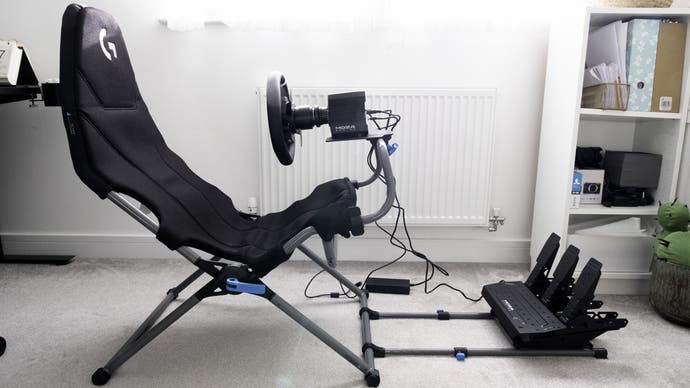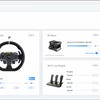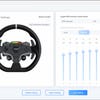Moza R5 Bundle + PlaySeat Challenge X review: two great entry-level choices for PC sim racing
They don't work well together - but we'd still recommend either.
After reviewing direct drive wheels and pedals from some of the biggest established players in sim racing - Fanatec, Thrustmaster and Logitech - I wanted to try something from a newer player in the space, Moza.
This Chinese firm is best known for its entry-level R5 Bundle, which brings a powerful 5.5nm direct drive wheelbase with a matching wheel and pedals to a quite affordable £459. For context, that's only £100 to £200 more than popular gear-driven and belt-driven racing wheels, like Logitech's G923 and Thrustmaster's T300, yet superior DD tech should translate into significantly faster and more detailed force feedback and a better driving experience overall.
Moza were happy to send out this PC-only bundle - with a couple of extra upgrades - and when Logitech got in touch to offer a £259 PlaySeat Challenge X folding racing cockpit, I had a complete racing setup for ~£700 with the potential to punch well above its weight.
Moza R5 Bundle review
The Moza R5 Bundle is one of the most affordable combinations of direct drive wheelbase, wheel and pedals on the market, currently retailing for around £459/$459 with a proper metal desk mount included. That compares favourably to the (originally €600, now €700) Fanatec GT DD Pro, although Fanatec's cheaper CSL DD Ready2Race bundle (which comes with a simpler PC-only rim and no desk mount) is available for €400.
I tested the Moza R5 over two weeks in an exhaustive series of single-player and multiplayer F1 23 sessions - plus a few stints in Dirt Rally 2.0 and Project Cars 3. Overall, I found this was a good setup - you get more powerful and detailed feedback from the 5.5nm wheelbase than with a cheaper belt-driven or gear-driven system, making it easier to judge the limits of traction and catch the car if you inadvertently step over that limit. (These direct drive systems also tend to be quieter than cheaper alternatives, which can be loud enough that you wouldn't want to use them in a shared space.) The Moza wheelbase is also smaller than the CSL DD, which might make mounting easier in some scenarios, but the Fanatec wheelbase can be side-mounted out of the box which is handy too. There's little to distinguish these two in terms of force feedback, but the Fanatec option can be boosted from 5nm to 8nm with a beefier power supply.
The ES racing wheel is one of the better entry-level wheels I've tried too, with a 280mm diameter and a good number of well-positioned buttons (that nonetheless have a bit of a cheap feeling when pressed). Similarly, the slightly spongy feeling paddle shifters don't feel as precise as even those on the Fanatec GT DD Pro. However, the wheel feels well built, with brushed aluminium used for the centre, a faux-leather wrapping for the D-shaped perimeter and a metal quick release that should hold up to extended use.
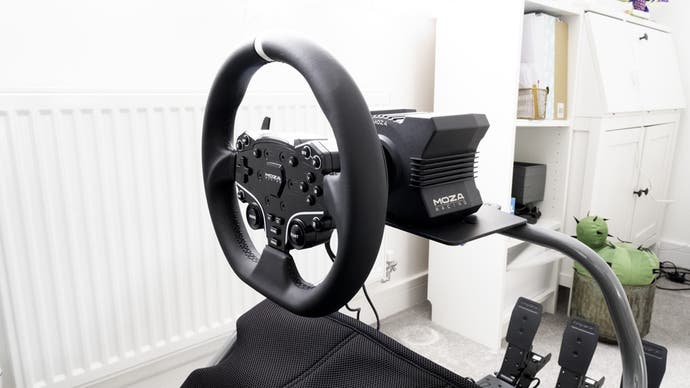

I also like the fact that you can pick up a kit, the £37 ES Formula Wheel Mod, that converts the wheel into a Formula-style shape that's ideal for playing the F1 games. Reviews online suggest this takes a few minutes to swap over, but this is certainly preferable to dropping another ~£200 on a separate Formula-style rim as you'd need to do in the Fanatec ecosystem, for example. Of course, far more expensive wheel rims are available too. The rim does look much better than that provided with the Fanatec GT DD Pro, with a more mature monochrome aesthetic, and comes with a simple but effective rainbow rev counter - plus mounting points for a proper LCD display.
While the wheelbase and wheel are good to great, depending on your point of reference, the pedals stood out as a bit of a weak point for me. They lacked a huge amount of tactile feedback when pressed and felt more akin to pedals you'd find on lower-end kit, like Logitech's G29 or G920. Moza do sell a stiff spring upgrade kit for the brake pedal and an extra clutch pedal, both of which I tried (detailed below), but the default two-pedal setup is fairly pedestrian when all things are considered. At least with a metal construction I have no doubts over its long-term durability.
Connecting the wheelbase and pedals is straightforward, with only a single connection for your two or three pedals and a USB cable to your PC, with a single button on the back of the wheelbase to turn it on.
Moza's Pit House software is surprisingly excellent, with simple yet comprehensive controls for settings adjustments and calibration, firmware updates and live input readouts. The whole process feels far more streamlined than Fanatec's slightly fragmented offering, and the Pit House software is also lighter while having seemingly more options than Logitech's G Hub. Overall, it's a great package.
Extras: Performance Kit for R5 Bundle + SR-P Lite Clutch Pedal
Moza kindly included two extras with the R5 Bundle I received: the £29 'Performance Kit for R5 Bundle', just a stiff brake pedal spring (which screws and slides into place on the brake pedal, rather than replacing something that's already installed), and the £44 'SR-P Lite Clutch Pedal' (which requires unscrewing the brake pedal from the left-most position, moving it to the centre, then adding the clutch pedal in its place and connecting a wire between the two pedals). These were both slightly unintuitive to install, especially given the instructions provided with the brake spring came with comically small illustrations - I eventually had to find the same photo online to see what I was aiming for. However, once I figured out what Moza wanted me to do, the process was pretty straightforward and took only a minute or two for each addition.
The brake pedal spring upgrade makes it feel more high-end than it was stock, with more realistically high braking force that more closely resembles other premium options I've tested, such as Thrustmaster's T-LCM pedals and Logitech's Pro Racing Pedals. Given the relatively meagre price of the upgrade, it's probably worth picking alongside the Moza R5 Bundle.
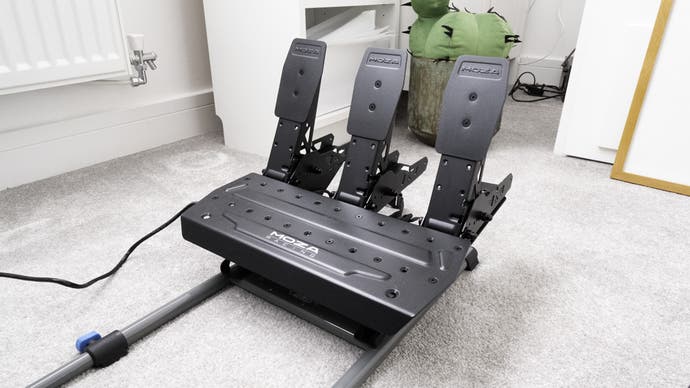
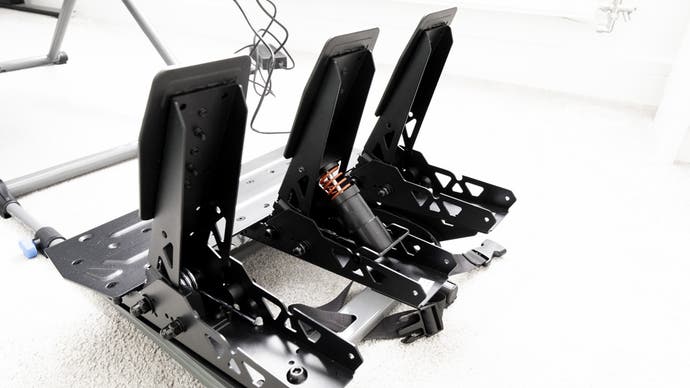
The clutch pedal was less revelationary, feeling near-identical to the stock accelerator and certainly sporting the same dimensions, but if you need a clutch pedal then this of course will do the job nicely. The pedal tray (such as it is) is quite wide, so you have the option of a comfortable gap between each pedal - good if you're wearing shoes or slippers - or a closer mount that makes it easier to perform heel-toe downshifting.
PlaySeat Challenge X review
The PlaySeat Challenge X is just as easy to set up as the PlaySeat Trophy we reviewed in the last episode of Will-gets-a-sim-racing-rig, with metal tubes connecting to each other to form a skeleton, over which an athletic fabric seat is stretched. From here, it's a simple matter of attaching wheel and pedal mounts - then your wheel and pedals to the mounts - and you're off to the races. There's even an optional bar for mounting a shifter too, which I didn't need but appreciated all the same.
All of the instructions provided are clearly illustrated, and it's evident that a lot of care was poured into ensuring that each step was hard to mess up - though my manual did show a different number and variety of screws than I was actually provided with, which made for a confusing start.
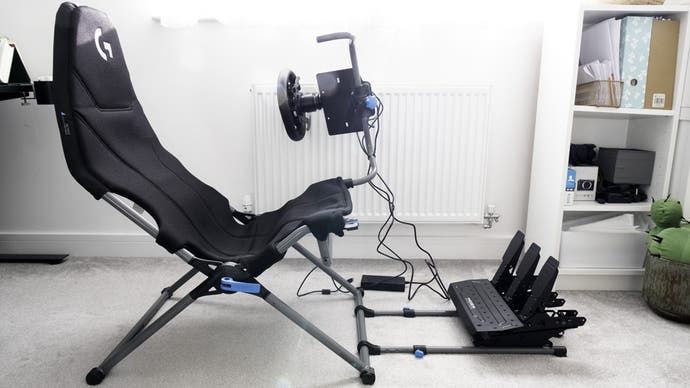
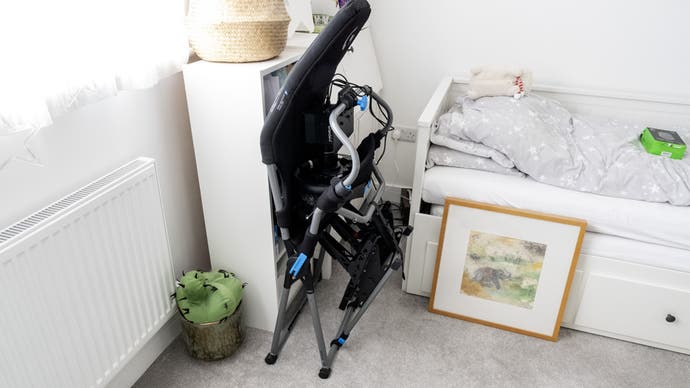
The Moza R5 wheel and pedals I'm using weren't a natural fit, unfortunately, as the wheel plate needed to be moved forward to allow bolts to go into the only two bolt holes of a matching width, while the split pedal plate needed to be mounted with its mounting holes extending outwards rather than inwards as shown in the instructions. (A £15 40mm to 66mm four-hole adapter is available online which would have made mounting easier, I think.) That said, figuring out what I needed to do was the tricky part; actually moving the bolts and screws using the provided Allen keys was quite straightforward. (Though I was able to make it work, I'd generally not recommend this particular combination of PlaySeat Challenge X racing cockpit and Moza R5 Bundle wheel/pedals, the reasons for which I'll detail later in this article.)
Once all components are properly placed, you can unlock and push open the wheel mount, rotating it out of the way so you can sit down without having to wriggle in like a worm, then replacing and locking it above you. There's also a little leg that sticks out on the right side to balance you further and the pedals are connected to the chair through telescoping legs that allow you to site them at a comfortable distance.
The chair is quite comfortable overall, with the athleisure-style fabric proving pleasant to sit in but not overly sweaty, but the headrest did dig into me somewhat and the more expensive PlaySeat Trophy is definitely the more comfortable PlaySeat x Logitech cockpit of the two. Still, the Challenge X feels perfectly stable even with a relatively powerful wheel connected with only two bolts, and that's impressive for a fold-up cockpit.
When you're not racing, you can unplug your wheel's power and USB connection, then collapse the chair to minimise its footprint, using two big handles on each side to reduce the angle between the front and back legs. The wheel rotates out of the way to allow for tighter positioning, and likewise the pedals rotate up to meet the rest of the chair and are secured with a simple buckled strap. There's space in the folded seat to stash your wheelbase power brick, racing shoes/gloves and so on too.
The direct drive wheel and pedals I'm using here are fairly substantial, so it didn't fold up as flat as the promotional materials suggested, but it still takes up less space than the PlaySeat Trophy (which simply tips back to attain a vertical position) and is lighter too, making it easier to move it from room to room or even up and down stairs if you fancy playing in the living room for a change.
In Combination: R5 Bundle + Challenge X
Ultimately, while the R5 and Challenge X are solid sim racing options, this particular combination isn't recommended. The big reason for this is that, with a three-pedal setup, the stiffer brake pedal isn't directly supported - it's floating in space - and this is the pedal that you're going to be hitting the hardest. I ended up removing the stiffer spring so that the entire set of pedals felt more secure, but the whole unit still moved noticeably during gameplay. This was compounded by the fact that the R5 pedals can only be secured at the top or the bottom; the Challenge X's pedal rack is too short to do both.
If I were running this long-term, I'd probably drill two fresh holes so that the bottom of the unit could be secured - or better yet, find a kind of metal plate that could act as a better interface between the pedals and the split pedal plate on the Challenge X. Failing that, and harming portability somewhat, it might even be better to place the pedals onto the floor or mount them onto a standalone pedal rack instead. You'd at least be able to remove the pedal part of the Challenge X entirely, making the wheel and chair portions lighter and easier to manage, but you would have to store both pieces separately and probably reconnect them after returning them from their location in storage.
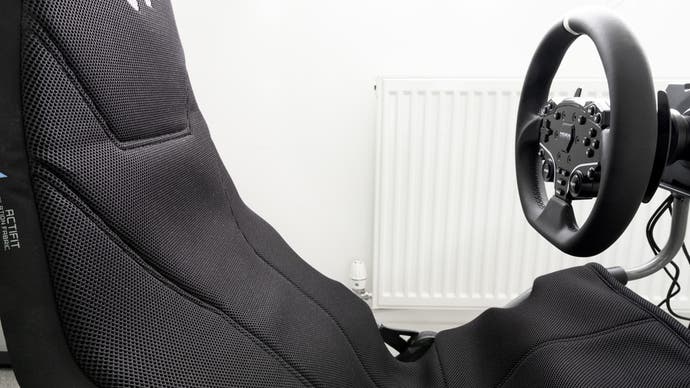

Of course, the better solution is just not running the Moza R5 and Challenge X in combination. Both feel like good (and good value) pieces of kit, but they just don't mesh together as nicely as I'd hoped. Of course, PlaySeat and Moza could and perhaps should work together to ensure that some of their most popular products - especially those in the same price classes - can actually be used with each other out of the box. Adding a base plate to the SR-P Lite pedals and a couple of extra holes in the Challenge X's pedal tray would make a world of difference!
Wrapping up
So while the Moza R5 Bundle and PlaySeat Challenge X weren't the natural bedfellows I expected, each of them on their own is well worth considering. The R5 Bundle delivers on its promise of a simple yet effective direct drive wheel, wheelbase and pedals, with bags of upgradeability - you can even add console support with a third-party converter widget. Meanwhile, the Challenge X is a comfortable, convenient and even kind-of-portable racing cockpit that is nearly as good as the more robust PlaySeat Trophy despite costing half as much.
Both come highly recommended then - I'd just suggest a Logitech wheel and pedals to pair with the Challenge X or any semi-robust cockpit with a larger one-piece pedal plate for the Moza R5 Bundle.
